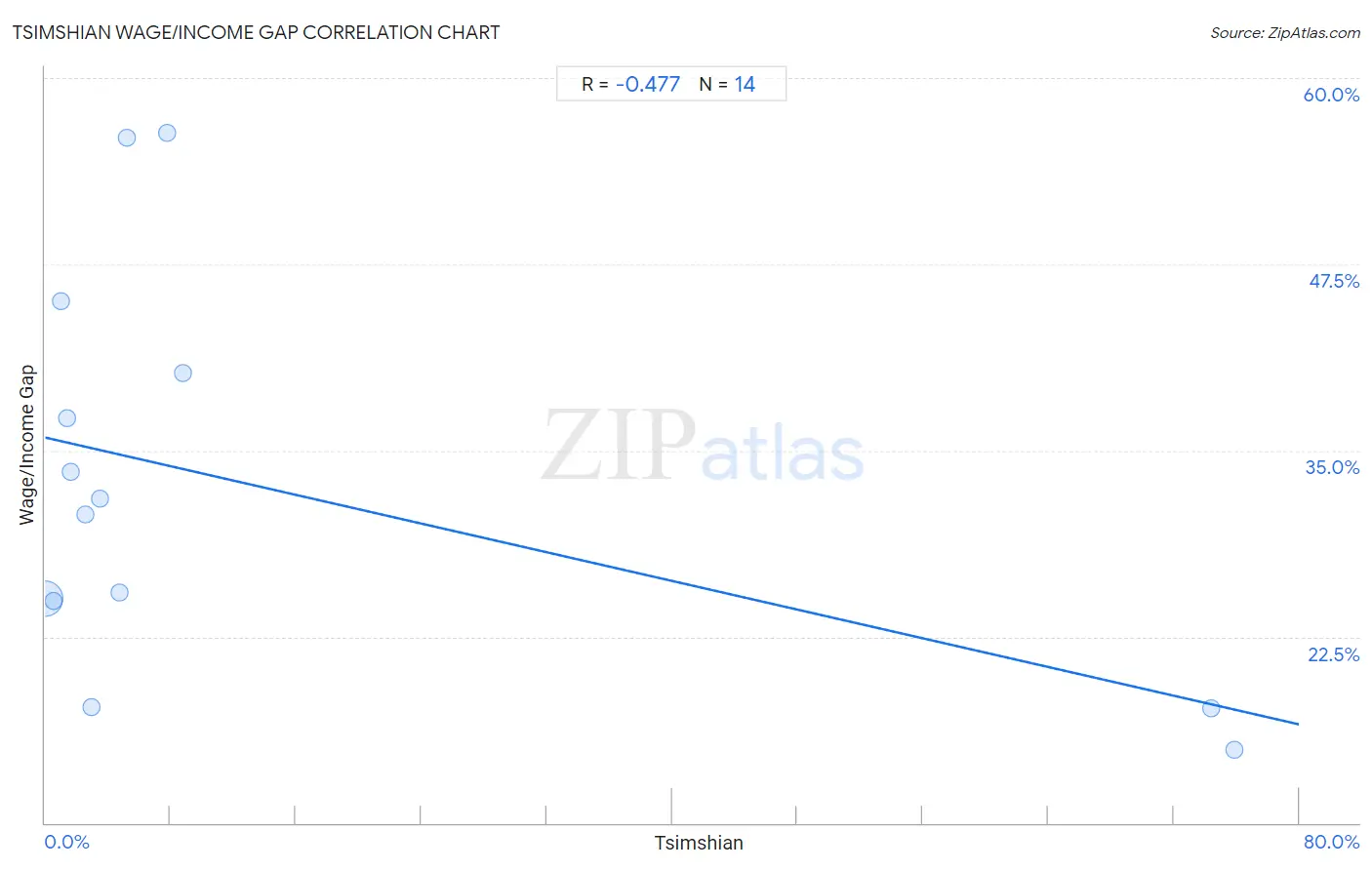Tsimshian Wage/Income Gap
COMPARE
Tsimshian
Select to Compare
Wage/Income Gap
Tsimshian Wage/Income Gap
23.9%
WAGE/INCOME GAP
98.9/ 100
METRIC RATING
103rd/ 347
METRIC RANK
Tsimshian Wage/Income Gap Correlation Chart
The statistical analysis conducted on geographies consisting of 15,623,634 people shows a moderate negative correlation between the proportion of Tsimshian and wage/income gap percentage in the United States with a correlation coefficient (R) of -0.477 and weighted average of 23.9%. On average, for every 1% (one percent) increase in Tsimshian within a typical geography, there is a decrease of 0.24% in wage/income gap percentage.

It is essential to understand that the correlation between the percentage of Tsimshian and wage/income gap percentage does not imply a direct cause-and-effect relationship. It remains uncertain whether the presence of Tsimshian influences an upward or downward trend in the level of wage/income gap percentage within an area, or if Tsimshian simply ended up residing in those areas with higher or lower levels of wage/income gap percentage due to other factors.
Demographics Similar to Tsimshian by Wage/Income Gap
In terms of wage/income gap, the demographic groups most similar to Tsimshian are Immigrants from Laos (23.8%, a difference of 0.23%), Tlingit-Haida (24.0%, a difference of 0.33%), Japanese (23.8%, a difference of 0.37%), Moroccan (24.0%, a difference of 0.39%), and Sudanese (24.0%, a difference of 0.39%).
| Demographics | Rating | Rank | Wage/Income Gap |
| Kiowa | 99.4 /100 | #96 | Exceptional 23.6% |
| Immigrants from Sudan | 99.4 /100 | #97 | Exceptional 23.6% |
| Immigrants from Latin America | 99.2 /100 | #98 | Exceptional 23.7% |
| Aleuts | 99.2 /100 | #99 | Exceptional 23.7% |
| Yakama | 99.2 /100 | #100 | Exceptional 23.7% |
| Japanese | 99.1 /100 | #101 | Exceptional 23.8% |
| Immigrants from Laos | 99.0 /100 | #102 | Exceptional 23.8% |
| Tsimshian | 98.9 /100 | #103 | Exceptional 23.9% |
| Tlingit-Haida | 98.7 /100 | #104 | Exceptional 24.0% |
| Moroccans | 98.6 /100 | #105 | Exceptional 24.0% |
| Sudanese | 98.6 /100 | #106 | Exceptional 24.0% |
| Yaqui | 98.4 /100 | #107 | Exceptional 24.0% |
| Immigrants from Albania | 98.4 /100 | #108 | Exceptional 24.0% |
| Ugandans | 98.3 /100 | #109 | Exceptional 24.1% |
| Immigrants from Morocco | 98.1 /100 | #110 | Exceptional 24.1% |
Tsimshian Wage/Income Gap Correlation Summary
| Measurement | Tsimshian Data | Wage/Income Gap Data |
| Minimum | 0.024% | 14.9% |
| Maximum | 75.9% | 56.3% |
| Range | 75.8% | 41.4% |
| Mean | 13.6% | 32.6% |
| Median | 3.2% | 31.2% |
| Interquartile 25% (IQ1) | 1.4% | 24.9% |
| Interquartile 75% (IQ3) | 7.8% | 40.2% |
| Interquartile Range (IQR) | 6.3% | 15.3% |
| Standard Deviation (Sample) | 26.2% | 13.2% |
| Standard Deviation (Population) | 25.2% | 12.7% |
Correlation Details
| Tsimshian Percentile | Sample Size | Wage/Income Gap |
[ 0.0% - 0.5% ] 0.024% | 15,404,738 | 25.0% |
[ 0.5% - 1.0% ] 0.53% | 170,082 | 24.9% |
[ 0.5% - 1.0% ] 0.99% | 15,580 | 45.0% |
[ 1.0% - 1.5% ] 1.41% | 3,326 | 37.2% |
[ 1.5% - 2.0% ] 1.62% | 804 | 33.6% |
[ 2.5% - 3.0% ] 2.53% | 1,736 | 30.7% |
[ 2.5% - 3.0% ] 2.92% | 822 | 17.7% |
[ 3.0% - 3.5% ] 3.46% | 13,913 | 31.8% |
[ 4.5% - 5.0% ] 4.77% | 8,168 | 25.5% |
[ 5.0% - 5.5% ] 5.18% | 656 | 56.0% |
[ 7.5% - 8.0% ] 7.76% | 361 | 56.3% |
[ 8.5% - 9.0% ] 8.79% | 546 | 40.2% |
[ 74.0% - 74.5% ] 74.40% | 1,465 | 17.7% |
[ 75.5% - 76.0% ] 75.85% | 1,437 | 14.9% |